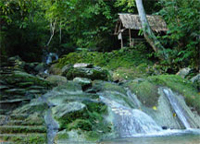 CARAGAcan be traced back to the 15th century when explorers discovered the existence of Kalagans, believed to be of Visayan Origin in one of the three districts in Mindanao. The word Caraga originated from the Visayan word “Kalagan”: “Kalag” meaning soul or people and “An” meaning land. The “Kalagans” have a long history of being brave and fearless. Thus, the region was called by early chroniclers as the “Land of the Brave and Fierce People.” CARAGAcan be traced back to the 15th century when explorers discovered the existence of Kalagans, believed to be of Visayan Origin in one of the three districts in Mindanao. The word Caraga originated from the Visayan word “Kalagan”: “Kalag” meaning soul or people and “An” meaning land. The “Kalagans” have a long history of being brave and fearless. Thus, the region was called by early chroniclers as the “Land of the Brave and Fierce People.”The “Kalagans”, called “Caragans” by the Spaniards occupied the district composed of the two provinces of Surigao, northern part of Davao Oriental and Eastern Misamis Oriental. The two Agusan Provinces were later organized under the administrative jurisdiction of Surigao and became the independent Agusan province in 1914. In 1960, Surigao was divided as Norte and Sur, and in June 1967, Agusan followed suit. While Butuan then was just a town of Agusan, the logging boom in 1950’s drew business and businessmen to the area. On August 2, 1950. by virtue of Republic Act 523, the City Charter of Butuan was approved.  CARAGA is an Administrative Region of the Philippines, on the northeastern portion of the island of Mindanao. It is the newest region in the Philippines, and is also called Region XIII. The Caraga Region was created through Republic Act Number 7901 on February 25, 1995. The region is composed of five (5) provinces: Agusan del Norte, Agusan del Sur, Surigao del Norte and Surigao del Sur, and the newly created province, Dinagat Islands (from Surigao del Norte); six (6) cities: Butuan, Surigao and Bislig, and recently, the newly created component cities: Cabadbaran, Bayugan, and Tandag; seventy (70) municipalities and 1,346 barangays. Butuan City is the regional center.It’s haven for tourists and adventurers. The region hosts two of the Philippines’ 10 National Integrated Protected Areas – the Siargao Seascape, and the 100,000-hectare Agusan Marsh Wildlife Sanctuary – as well as world class dive, surfing, and sport fishing sites, mountains trekking and biking, white sand beaches, hot and cold springs, caves, rivers, forests, and waterfalls.If you are seeking a challenging experience or simply an escapade from the humdrum of urban life, venture no more… Come and experience adventure one can find south of the Philippines islands that simply lures visitors to frolic in its pristine beauty. CARAGA is an Administrative Region of the Philippines, on the northeastern portion of the island of Mindanao. It is the newest region in the Philippines, and is also called Region XIII. The Caraga Region was created through Republic Act Number 7901 on February 25, 1995. The region is composed of five (5) provinces: Agusan del Norte, Agusan del Sur, Surigao del Norte and Surigao del Sur, and the newly created province, Dinagat Islands (from Surigao del Norte); six (6) cities: Butuan, Surigao and Bislig, and recently, the newly created component cities: Cabadbaran, Bayugan, and Tandag; seventy (70) municipalities and 1,346 barangays. Butuan City is the regional center.It’s haven for tourists and adventurers. The region hosts two of the Philippines’ 10 National Integrated Protected Areas – the Siargao Seascape, and the 100,000-hectare Agusan Marsh Wildlife Sanctuary – as well as world class dive, surfing, and sport fishing sites, mountains trekking and biking, white sand beaches, hot and cold springs, caves, rivers, forests, and waterfalls.If you are seeking a challenging experience or simply an escapade from the humdrum of urban life, venture no more… Come and experience adventure one can find south of the Philippines islands that simply lures visitors to frolic in its pristine beauty.
|
























